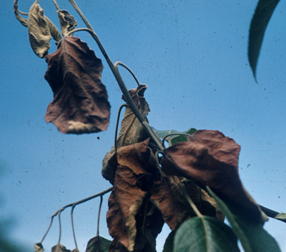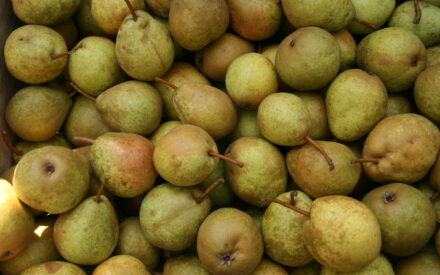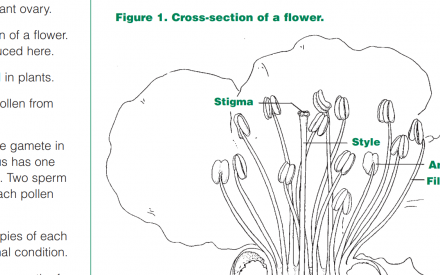What is fire blight?

Fire blight is the most destructive bacterial disease affecting plants in the rose family, including apple, pear, crabapple, hawthorn, cotoneaster, mountain ash, quince, rose, firethorn (Pyracantha), and spirea. It can disfigure or kill a tree or shrub, depending on the susceptibility of the host and weather conditions.
What does fire blight look like?
Blossoms, leaves, twigs, and branches of plants affected by fire blight can turn dark brown to black, giving them the appearance of having been scorched in a fire. Blighted blossoms and leaves tend to stay on the tree instead of falling. The current year’s twigs often wilt and bend approximately 180°, forming a “shepherd’s crook.” Cankers (sunken, discolored areas) form on branches and stems, and emit a sticky bacterial ooze. Sapwood under the bark around cankers can become reddish brown in color. Fruits can develop brown, sunken or shriveled areas that can be sticky.
Where does fire blight come from?
Fire blight is caused by the bacterium Erwinia amylovora, which overwinters on the margins of branch cankers and starts to multiply when temperatures rise in the spring. A bacterium-laden ooze seeps from cankers, and splashing rain and insects disperse this material. In particular, pollinators such as honeybees can feed on the ooze and then transport the fire blight bacterium to flowers as they collect pollen. The fire blight bacterium multiplies in blossoms and eventually can spread to other plant parts where it penetrates through wounds and natural openings. Once the bacterium enters a plant, it can spread rapidly through the plant’s water-conducting (vascular) system.
How do I save a plant with fire blight?
There is no cure for fire blight, but its spread can be limited by pruning out diseased branches. Because the fire blight bacterium can spread rapidly, prune as soon as possible after symptoms become visible. Prune when branches are dry and when your local weather service predicts several days of dry weather. When removing diseased branches, prune at least 12 inches below tissue showing visible symptoms. Always disinfect pruning tools after each cut by treating them for at least 30 seconds with bleach [diluted to a final concentration of approximately 0.5% sodium hypochlorite (the active ingredient)] or (preferably) 70% alcohol (e.g., rubbing alcohol, certain spray disinfectants). If you use bleach, be sure to thoroughly rinse and oil your tools after pruning to prevent rusting. Burn or bury pruned branches.
How do I avoid problems with fire blight in the future?
By far the most effective strategy is to choose plants with fire blight resistance. Also, select a well-drained site with a soil pH of 5.5 to 6.5. Avoid applying high levels of nitrogen fertilizer, as this may stimulate new, succulent growth that is more prone to damage and thus infection. Consider treating with Bordeaux mixture (copper sulfate + lime) before buds open to reduce the level of the fire blight bacterium present on branches. Make one or two applications, with four days between applications.
For more information on fire blight:
Contact the University of Wisconsin Plant Disease Diagnostics Clinic (PDDC) at (608) 262-2863 or pddc@wisc.edu.
Authors: Ann Joy and Brian Hudelson, UW-Madison Plant Pathology
Last Revised: 03/01/2024
D-number: D0052
Thanks to Teryl Roper, Patricia McManus, and Patti Nagai for reviewing this document.
A complete inventory of UW Plant Disease Facts is available at the University of Wisconsin-Madison Plant Disease Diagnostics Clinic website: https://pddc.wisc.edu.
Send a Plant Sample for Analysis
Be cautious when self-diagnosing plant health issues. Very few diseases can accurately be diagnosed by eye.
Contact the UW Plant Disease Diagnostics Clinic (PDDC), and for a small fee, clinic staff can examine a plant, determine the cause of the disease/disorder, and provide advice on how to control or prevent the issue.
Download Article





 Growing Apples in Wisconsin
Growing Apples in Wisconsin Growing Pears in Wisconsin
Growing Pears in Wisconsin Apple Pest Management for Home Gardeners
Apple Pest Management for Home Gardeners Fruit Crop Pollination
Fruit Crop Pollination


